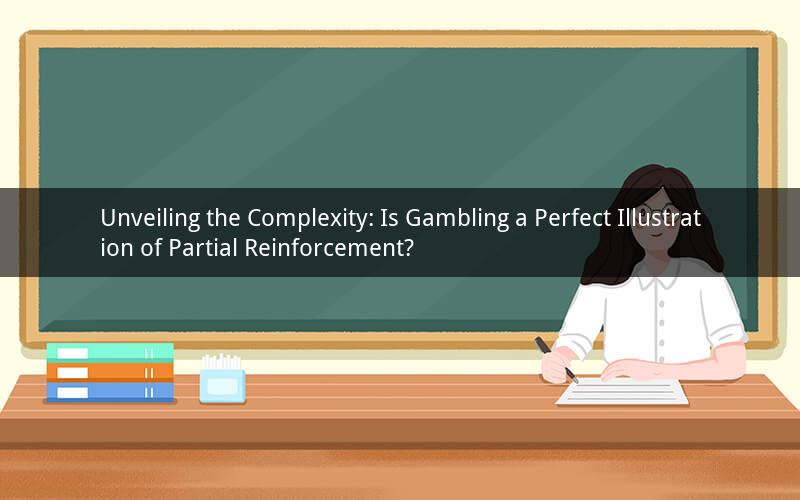
Introduction:
Gambling, an age-old activity that has captivated countless individuals across the globe, raises intriguing questions about its underlying psychological mechanisms. One such mechanism is partial reinforcement, which plays a pivotal role in shaping our behaviors. In this article, we delve into the enigma of gambling and explore whether it can be deemed as a quintessential example of partial reinforcement.
Section 1: Understanding Partial Reinforcement
To grasp the concept of partial reinforcement, let's first dissect its definition. Partial reinforcement refers to the delivery of reinforcement after an unpredictable number of responses, leading to an increased likelihood of those responses being repeated. This concept is often associated with the principles of operant conditioning, as proposed by B.F. Skinner.
Section 2: The Link between Gambling and Partial Reinforcement
Now that we have a clear understanding of partial reinforcement, let's investigate its presence in the realm of gambling. Gamblers are exposed to a constant flow of reinforcement, albeit in a highly unpredictable manner. This aspect aligns seamlessly with the characteristics of partial reinforcement. In this section, we explore how gambling exemplifies the principles of partial reinforcement.
2.1 The Role of Random Reinforcement:
In gambling, the outcome of each bet is inherently random. This random reinforcement creates a sense of uncertainty, keeping gamblers on their toes. As gamblers continue to engage in the activity, they are repeatedly reinforced, albeit intermittently. This intermittent reinforcement is a hallmark of partial reinforcement.
2.2 The Impact on Gamblers' Behavior:
The unpredictable nature of reinforcement in gambling fosters a heightened level of motivation. Gamblers are driven to continue engaging in the activity in the hope of encountering a winning streak, which serves as a powerful reinforcer. This drive to repeat the behavior, despite the intermittent reinforcement, exemplifies the principles of partial reinforcement.
Section 3: The Dilemma of Gambling Addiction
While the concept of partial reinforcement explains the allure of gambling, it also raises concerns about its potential addictive nature. In this section, we delve into the psychological mechanisms that contribute to gambling addiction and how they are intertwined with the principles of partial reinforcement.
3.1 The Role of Craving:
Gamblers often experience a strong craving to engage in gambling activities. This craving is a direct consequence of the intermittent reinforcement they receive. The uncertainty surrounding the reinforcement strengthens the desire to continue participating, leading to the development of gambling addiction.
3.2 The Cycle of Compulsion:
The intermittent reinforcement in gambling creates a cycle of compulsion. Gamblers become fixated on the possibility of achieving a winning streak, driven by the intermittent reinforcement they receive. This compulsion leads to a relentless pursuit of the activity, even when faced with negative consequences.
Section 4: The Psychological Implications of Gambling and Partial Reinforcement
The intertwining of gambling and partial reinforcement has significant psychological implications. In this section, we explore the psychological effects of gambling and how they are influenced by the principles of partial reinforcement.
4.1 Cognitive Distortions:
Gamblers often develop cognitive distortions that perpetuate their involvement in the activity. The intermittent reinforcement they receive creates a false belief that their chances of winning are higher than they actually are. This distorted perception further reinforces their gambling behavior.
4.2 Emotional Consequences:
Gambling can evoke a range of emotions, including excitement, anxiety, and frustration. These emotions are intertwined with the intermittent reinforcement, as gamblers become emotionally invested in the outcomes of their bets. The psychological impact of these emotions can be both detrimental and reinforcing.
Section 5: Addressing the Challenges of Gambling and Partial Reinforcement
Given the intricate relationship between gambling and partial reinforcement, addressing the challenges posed by gambling addiction becomes crucial. In this section, we discuss strategies to mitigate the negative effects of gambling and promote healthier behaviors.
5.1 Awareness and Education:
Increasing awareness about the psychological aspects of gambling can help individuals recognize the signs of addiction. Education about the principles of partial reinforcement can empower individuals to make informed decisions and seek help when needed.
5.2 Professional Support:
Seeking professional support from psychologists or therapists can be instrumental in addressing gambling addiction. Therapists can help individuals develop coping strategies, address underlying psychological issues, and develop healthier behaviors.
5.3 Self-Regulation and Support Networks:
Developing self-regulation skills is crucial in combating gambling addiction. Setting limits on gambling activities, identifying triggers, and building support networks can provide individuals with the necessary resources to overcome addiction.
5.4 Social and Legal Interventions:
Social and legal interventions can also play a significant role in addressing the challenges of gambling. Implementing regulations that limit access to gambling venues, providing support for problem gamblers, and promoting responsible gambling practices can contribute to a healthier society.
Conclusion:
Gambling, with its intricate relationship to partial reinforcement, presents a complex psychological phenomenon. While the intermittent reinforcement experienced by gamblers may explain their continued engagement in the activity, it also raises concerns about addiction and its negative consequences. Understanding the psychological mechanisms underlying gambling can pave the way for effective interventions and promote a healthier society.
Questions:
1. How does the concept of partial reinforcement contribute to the addictive nature of gambling?
2. What are some cognitive distortions that gamblers often experience due to intermittent reinforcement?
3. How can individuals develop self-regulation skills to combat gambling addiction?
4. What role can professional support play in addressing gambling addiction?
5. How can social and legal interventions contribute to mitigating the challenges posed by gambling?